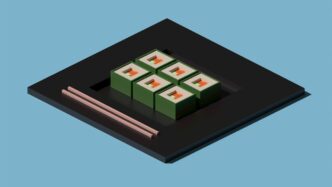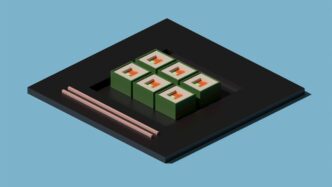So, Google made a big splash back in 2019 with their Sycamore quantum computer. They said it did something that would take regular computers thousands of years. It was a huge deal, like the first time a quantum machine really showed it could beat the best classical ones at a specific job. But, like most things in tech, it wasn’t quite that simple. Other companies, like IBM, chimed in, saying maybe it wasn’t *that* impossible for regular computers if you got clever with the methods. It’s a bit like saying you climbed Mount Everest, and someone else says, ‘Yeah, but I could have done it if I had a helicopter.’ Still, the Sycamore quantum computer definitely pushed the whole field forward, showing us what these machines might be capable of.
Key Takeaways
- The Sycamore quantum computer, announced by Google in 2019, performed a specific calculation in about 200 seconds that was estimated to take classical supercomputers 10,000 years.
- This event, often called ‘quantum supremacy,’ marked a significant moment where a quantum device demonstrably outperformed classical computers on a defined task.
- Rival companies, like IBM, questioned the 10,000-year estimate, suggesting that with different algorithms and more storage, classical computers could perform the task much faster, though still significantly slower than Sycamore.
- Sycamore used 53 superconducting transmon qubits arranged in a lattice and relied on techniques like synchronized gate calibration and cross-entropy benchmarking for its operations.
- While Sycamore’s achievement was a landmark, it highlighted the ongoing challenges in quantum computing, particularly the need for better error correction and scaling to tackle more complex, practical problems.
Sycamore Quantum Computer: A New Era of Computation
It feels like just yesterday we were hearing about quantum computers in hushed tones, like some far-off science fiction concept. But then came Google’s Sycamore processor, and suddenly, it felt a lot more real. This wasn’t just another incremental step; it was a leap. Think about it: a machine performing a calculation in minutes that would take our best supercomputers thousands of years. That’s the kind of jump that changes everything.
Defining Quantum Supremacy with Sycamore
So, what exactly is this "quantum supremacy" everyone was talking about? It’s basically the point where a quantum computer can do something that no classical computer can realistically do. Google’s Sycamore processor hit this mark by tackling a very specific, complex task: sampling the output of a random quantum circuit. Imagine trying to predict the exact probabilities of a million different outcomes from a highly complex, random quantum process. For Sycamore, it took about 200 seconds. For the most powerful classical supercomputers out there, the estimate was around 10,000 years. It’s a stark difference, showing that for certain problems, quantum machines have a serious edge. This achievement really validated the idea that quantum computers aren’t just theoretical curiosities anymore; they can actually outperform classical machines on specific tasks. It’s a big deal for the future of computing research.
The Sycamore Processor: Architecture and Operation
Let’s talk a bit about how Sycamore actually works. At its heart, it uses superconducting transmon qubits. These are essentially tiny electrical circuits, cooled down to extremely low temperatures, where they start behaving according to quantum rules. Sycamore has 54 of these qubits, though in the famous experiment, one wasn’t quite cooperating, leaving 53 in play. They’re arranged in a grid, and the processor runs a sequence of operations, like nudges and entanglements, across these qubits. After about 20 rounds of these operations, the qubits enter a complex quantum state. The job is to sample from the possible outcomes of this state, which is where the classical computers really struggle to keep up.
Google’s Landmark Achievement in Quantum Computing
This whole Sycamore event in October 2019 was a major moment. It wasn’t just Google; other researchers and institutions, like NASA and Oak Ridge National Laboratory, were involved in checking the results. They called it a "transformative achievement." It showed that a programmable quantum device could indeed do something beyond the reach of even the most advanced classical systems. It’s like finally seeing a car that can break the sound barrier – it proves a new kind of performance is possible. This success built on decades of work in quantum computing, from early experiments with just a few qubits to the development of more complex architectures.
Sycamore’s Performance Versus Classical Computing
So, Google’s Sycamore processor made a big splash back in 2019, claiming it could do a calculation in about 200 seconds that would take the best supercomputers of the day 10,000 years. That’s pretty wild, right? It was all about something called "quantum supremacy," basically showing a quantum computer could tackle a problem that’s just too much for even the most powerful regular computers.
The 10,000-Year Calculation: Sycamore’s Speed
This was the headline grabber. Google’s Sycamore, with its 53 working qubits, was tasked with sampling the output of a random quantum circuit. Think of it like trying to predict the exact outcome of a super complex, multi-stage coin flip, but with quantum rules. The sheer number of possible outcomes, $2^{53}$, is astronomical. Google said their quantum chip crunched this in just over three minutes. For a classical supercomputer, like IBM’s Summit at the time, simulating this same process was estimated to take millennia. It was a huge moment, suggesting quantum machines were entering a new league.
Challenging Google’s Supremacy Claims
Now, not everyone was totally convinced. IBM, a big player in quantum computing themselves, chimed in. They argued that Google’s 10,000-year estimate was a bit high. IBM suggested that with some clever programming tricks and a lot of hard drive space, a supercomputer could actually do the job in about 2.5 days. That’s still way longer than Sycamore’s few minutes, but it definitely narrowed the gap and made people think twice about the absolute
Sycamore Quantum Computer: Technical Innovations
Superconducting Transmon Qubits in Sycamore
So, Google’s Sycamore processor is built using something called superconducting transmon qubits. Think of them as tiny electrical circuits, really small ones, that are cooled down to super cold temperatures, close to absolute zero. At these frigid temperatures, these circuits start acting like quantum objects. Sycamore actually has 54 of these qubits, though during their big experiment, one of them wasn’t working, so they used 53. They’re arranged in a grid, like a checkerboard, and they can only really talk to their immediate neighbors. The whole point is to get these qubits into a state where they’re all linked up, a sort of quantum entanglement, and then have them do a specific job.
High Fidelity Operations and Error Minimization
Now, getting these qubits to do what you want them to do, and doing it accurately, is the tricky part. The team focused on making sure the operations, the ‘moves’ they make with the qubits, were as precise as possible. This is what they call ‘fidelity’. Even with Sycamore, the fidelity wasn’t perfect. For instance, after about 20 steps, or ‘cycles’, of operations, errors started to really mess things up. This means that for any really complex problem, like the ones we might need quantum computers for in the future, they’ll need to either make these operations even more accurate or find ways to fix the errors as they happen. It’s a big challenge, for sure.
Cross-Entropy Benchmarking for Validation
To prove that Sycamore was actually doing what they claimed, they used a method called cross-entropy benchmarking. Basically, they ran the same random quantum circuit many times and looked at the results. They compared the actual output from Sycamore to what they expected based on theory. If the results matched the predictions, it meant the processor was working correctly and producing the right kind of random numbers. This is how they could be pretty sure that Sycamore was indeed performing a task that was incredibly difficult for regular computers. It’s like a quality check to make sure the quantum magic is actually happening.
Sycamore’s Place in Quantum Computing History
It’s easy to get caught up in the hype, but understanding where Sycamore fits in the grand scheme of things is pretty important. Think of it like this: for years, people were building better and better bicycles. Then, someone invented the car. Sycamore wasn’t the first car, but it was definitely one of the first that really showed everyone what a car could do, especially compared to the best bicycles available at the time.
Comparing Sycamore to Earlier Quantum Milestones
Before Sycamore came along, there were a lot of impressive steps. Back in 2001, IBM managed to factor the number 15 using a 7-qubit computer. That was a big deal, proving Shor’s algorithm actually worked. Then there were photonic computers trying to do something called boson sampling. They showed it was possible in theory, but the early experiments were with just a few photons, not enough to really beat a regular computer. Throughout the 2000s and 2010s, different groups kept improving their quantum hardware – more qubits, longer coherence times, better entanglement. It was all steady progress, building the foundation.
The NISQ Era and Sycamore’s Breakthrough
By the late 2010s, we entered what’s called the NISQ era – Noisy Intermediate-Scale Quantum. These were machines with around 50 to 100 qubits, but they weren’t perfect. They had noise, and no real error correction. The idea was that maybe, just maybe, these imperfect machines could still do something useful that classical computers couldn’t. Google’s Sycamore was the first one to really prove that point. It took that NISQ concept and pushed it past a theoretical possibility into a demonstrated reality for a specific task.
Sycamore’s Impact on Future Quantum Development
So, what did Sycamore actually change? Well, it showed that building these complex quantum systems was possible and that they could, in fact, outperform classical computers on certain problems. It also highlighted the next big hurdles. Sycamore’s fidelity wasn’t perfect, meaning errors crept in. To do really complex stuff, like breaking modern encryption or simulating large molecules, we’ll need much better error rates or actual error correction. Sycamore gave us a benchmark, a point to measure against. It proved the concept, and now the race is on to build better, more reliable machines that can tackle even harder problems, hopefully ones that actually help us in the real world.
Implications of the Sycamore Quantum Computer
So, what does all this mean for us, really? The Sycamore processor’s big moment, showing it could do a calculation way faster than even the best regular computers, is a pretty big deal. It’s not like it suddenly solved world hunger or anything, but it’s a huge step. Think of it like the first time a plane flew – it didn’t go very far, but it proved that flying was possible. This experiment proves that quantum computers, even the ones we have now that aren’t perfect, can actually do things classical computers just can’t.
Transformative Potential for Industries
This isn’t just about bragging rights. The techniques Google used to build and test Sycamore are like a roadmap for making even bigger and better quantum computers. This could change a lot of fields:
- Drug Discovery and Materials Science: Imagine designing new medicines or materials atom by atom. Quantum computers could simulate molecules in ways we can only dream of now, speeding up research dramatically.
- Financial Modeling: Complex financial markets involve so many variables. Quantum computers might be able to analyze these systems much more effectively, leading to better predictions and risk management.
- Artificial Intelligence: Certain AI tasks, especially those involving complex pattern recognition or optimization, could see massive speedups with quantum assistance.
Addressing Intractable Problems with Quantum Power
There are problems out there that are just too hard for today’s computers. We’re talking about things like:
- Optimization Problems: Finding the best solution among a huge number of possibilities, like optimizing delivery routes for a massive logistics company or finding the most efficient way to manage a power grid.
- Cryptography: While this is a double-edged sword (quantum computers could break current encryption), it also means we need to develop new, quantum-resistant encryption methods.
- Scientific Simulation: Simulating complex physical systems, from weather patterns to the behavior of subatomic particles, could become much more accurate and faster.
The Road Ahead: Scaling and Error Correction
Sycamore showed us what’s possible, but it also highlighted the next big hurdles. The computer made some mistakes, and for really useful tasks, we need to get those errors way down. So, the next steps are all about:
- More Qubits: Building processors with many more qubits.
- Better Fidelity: Making sure each quantum operation is super accurate.
- Error Correction: Developing ways to automatically fix errors as they happen, which is key for running longer, more complex calculations.
It’s a tough road, but Sycamore’s success gives everyone in the field a big boost of confidence that we’re heading in the right direction.
The Sycamore Quantum Computer and Its Rivals
When Google announced its Sycamore processor had achieved quantum supremacy, it wasn’t just a solo act. The whole field of quantum computing has been buzzing for years, with different companies and research groups pushing the boundaries. It’s kind of like a race, but everyone’s trying to build the fastest car, and they’re all using slightly different engines.
IBM’s Superconducting Qubits and Quantum Volume
IBM has been a major player in this space, especially with their superconducting qubits, which are pretty similar to what Google uses. They’ve been steadily increasing the number of qubits in their processors, putting a 5-qubit device on the cloud way back in 2016. By 2017, they had 16 and then 20 qubits. They even showed off a 50-qubit prototype in 2017, which many thought could be the threshold for quantum supremacy. But IBM was always a bit more cautious with the term. They came up with something called "Quantum Volume" to measure how well their systems were doing overall, looking at qubit count, how long qubits stay stable (coherence time), how they connect, and how accurate their operations are. By 2019, their best systems had a Quantum Volume of 16. When Google’s results came out, IBM pointed out that their own simulations could do the same task much faster than Google initially claimed, though it still took days on a supercomputer. This whole exchange really shows that "supremacy" isn’t a fixed point; it keeps changing as classical computer methods get better. Still, IBM’s earlier work, while impressive, hadn’t quite crossed that line where classical computers just couldn’t keep up.
The Friendly Rivalry in Quantum Advancement
This competition between companies like Google and IBM is actually a good thing for quantum computing. It pushes everyone to innovate faster and be more rigorous in their claims. Think of it as a healthy rivalry. When one company makes a big announcement, it spurs others to respond, either by improving their own systems or by scrutinizing the results. This back-and-forth helps the entire field move forward. It’s not just about being first, but about building reliable and powerful quantum machines. The progress made by IBM, for example, in developing integrated systems like the IBM Q System One, shows a focus on making quantum computers more practical and accessible, even if they haven’t claimed supremacy yet. It’s this kind of steady, practical advancement that complements the more headline-grabbing supremacy demonstrations.
Sycamore’s Distinction from Other Quantum Approaches
While Google and IBM focus on superconducting qubits, other groups are exploring different paths. For instance, trapped-ion quantum computers use charged atoms held in place by electromagnetic fields. These systems often boast very high qubit quality and connectivity, meaning the qubits can interact with each other more easily. Another approach is quantum annealing, famously pursued by D-Wave Systems. These machines are designed for specific types of problems, like optimization, rather than general-purpose computation. Photonic quantum computing uses light particles (photons) to perform calculations. Each of these methods has its own strengths and weaknesses. Sycamore’s distinction lies in its specific architecture and the demonstration of quantum advantage on a particular sampling task using superconducting transmon qubits. It showed that this particular approach, at a certain scale, could indeed outperform classical methods for a defined problem, building on years of research in quantum computing utilizes quantum-mechanical phenomena.
What’s Next for Quantum Computing?
So, Google’s Sycamore chip really did something special back in 2019, showing a quantum computer could tackle a problem way too tough for even the best regular computers. It wasn’t perfect, and folks like IBM pointed out that classical computers could maybe do the job faster than Google first thought. But still, it was a big deal. It proved that these quantum machines, even the ones with a few errors like Sycamore, are moving beyond just theory and can actually do things we couldn’t before. The real challenge now is making these machines more reliable and building them bigger, aiming for tasks that actually help us solve real-world problems. It’s a race, for sure, but Sycamore showed us we’re definitely on the right track.
Frequently Asked Questions
What exactly is the Sycamore quantum computer?
Imagine a special kind of computer that uses the weird rules of quantum physics to do calculations. Google’s Sycamore computer is one of these. It’s like a super-fast calculator for very specific, tricky problems that regular computers would take ages to solve. Think of it as a new type of tool that can tackle challenges we couldn’t before.
What does ‘quantum supremacy’ mean for Sycamore?
Quantum supremacy is like reaching a finish line. It’s when a quantum computer does a job so much faster than the best regular computer that it’s practically impossible for the regular computer to keep up. Sycamore showed it could do a particular math problem in about 3 minutes, while a super-fast regular computer would need thousands of years. That’s the ‘supremacy’ part.
How does Sycamore’s technology work?
Sycamore uses tiny parts called ‘superconducting transmon qubits.’ These are like special switches that can be either 0, 1, or both at the same time, thanks to quantum physics. They have to be kept super cold, almost as cold as outer space, to work properly. Google arranged these qubits in a grid to perform its calculations.
Did Sycamore make any mistakes?
While Sycamore was a huge step, it’s not perfect. It made some mistakes, meaning the results weren’t always exactly right. This is because quantum computers are very sensitive and prone to errors. Scientists are working hard to make these computers more accurate and reliable, which is a big challenge for building useful quantum machines.
How is Sycamore different from earlier quantum computers?
Before Sycamore, scientists had made smaller quantum computers that did cool things, but none had proven they could beat regular computers at a real task. Sycamore was the first to clearly show that a quantum computer could do something that regular computers just can’t do in a reasonable amount of time. It proved that quantum computers are a real and powerful new way to compute.
What could Sycamore and future quantum computers do for us?
Quantum computers like Sycamore could change many fields. They might help discover new medicines, create better materials, improve financial modeling, and even break current internet security. However, these powerful applications are still a long way off. We need to build bigger, more accurate quantum computers first.














